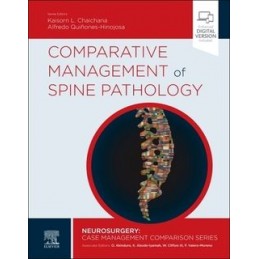- Reduced price

Order to parcel locker

easy pay


 Delivery policy
Delivery policy
Choose Paczkomat Inpost, Orlen Paczka, DHL, DPD or Poczta Polska. Click for more details
 Security policy
Security policy
Pay with a quick bank transfer, payment card or cash on delivery. Click for more details
 Return policy
Return policy
If you are a consumer, you can return the goods within 14 days. Click for more details
Data sheet
One level cervical radiculopathy from facet/uncovertebral joint hypertrophy
One level cervical radiculopathy from herniated disc?in young patient
One level cervical radiculopathy from herniated disc?in older patient
Cervical stenosis with preservation of lordosis
Adjacent segment disease after single level ACDF
Adjacent segment disease after PCF (cervicothoracic junction)
Multilevel cervical stenosis from OPLL
Multilevel cervical stenosis from 3-4 discs
Anterior C1-2 pannus
Basilar impression
Thoracolumbar
Adjacent segment disease at thoracolumbar junction
Thoracic calcified disc (central)
Lower thoracic disc herniation
High lumbar stenosis (thoracolumbar junction)
Lumbosacral
Single level disc disease with back pain
Radiculopathy from foraminal stenosis?
Grade 1 spondy without instability on flex/ext and claudication
Grade 1 spondy with back pain only?
Grade 2/3 spondy
>Grade 3 spondy
Second herniated disc (same level) in a young patient
Second herniated disc (same level) in older patient
Flat back syndrome after laminectomy?
Lumbar pseudoarthrosis at L5-S1
Pure back pain with multi level degenerative disc disease
2.?????????Traumatic spine (10-15)
Cervical
Bilateral C2 pars fractures
Type II acute odontoid fracture
Type II chronic odontoid fracture in geriatric patient
Unilateral cervical pedicle/transverse foramen fracture
Central cord syndrome without instability
Central cord with instability Vertebral artery injury with unstable cervical spine
C1 burst fracture with TL disruption
Thoracolumbar
Compression fracture with back pain
Burst fracture without PLC injury
Burst fracture with PLC injury
Pure bony Chance fracture
Ankylosing spondylotic fracture
Complete spinal cord injury
Incomplete spinal cord injury
Gunshot wound to the spine
Lumbosacral
Compression fracture
Burst fracture without PLC injury
Burst fracture with PLC injury
Zone 3 sacral fracture
Chronic L5 pars fractures with back pain and spondy
3.?????????Spinal deformity
Adolescent idiopathic scoliosis
Scoliosis in cerebral palsy
Proximal junctional kyphosis after T10-pelvis?
Isolated coronal deformity with back pain
Coronal and sagittal deformity with back pain (adult idiopathic)
Flat back after fusion
Progressive cervical kyphosis after laminectomy?
Fixed cervical kyphosis (chin on chest)
Degenerative scoliosis with one level radiculopathy?
Proximal junctional kyphosis after T3-pelvis?
Iatrogenic deformity after Harrington rod
Broken rod after scoliosis correction with back pain
4.?????????Spinal Oncology (10-15)
Isolated met vertebral body (thoracic)
Cervical epidural met (ventral)
Multiple metastases to various levels, back pain only?
Multiple metastases with one level symptomatic
Pathologic vertebral body fracture
Meningioma
Cervical chordoma
Sacral chordoma
Chondrosarcoma?
Schwannoma
Ependymoma
Glioma
Giant Cell tumor?
Schwannoma
Multiple neurofibromas?
Intradural schwannomatosis?
Hemangioblastoma
5.?????????Other (epidural abscess or something like that) (10-15)
Spontaneous CSF leak nerve root sleeve cyst
Epidural abscess with stenosis without myelopathy?
Osteomyelitis with fracture?
Osteomyeltiis with back pain, no instability?
Infection post instrumentation
Spinal Type I AVF
Reference: 74781
Author: Joseph S Butler
